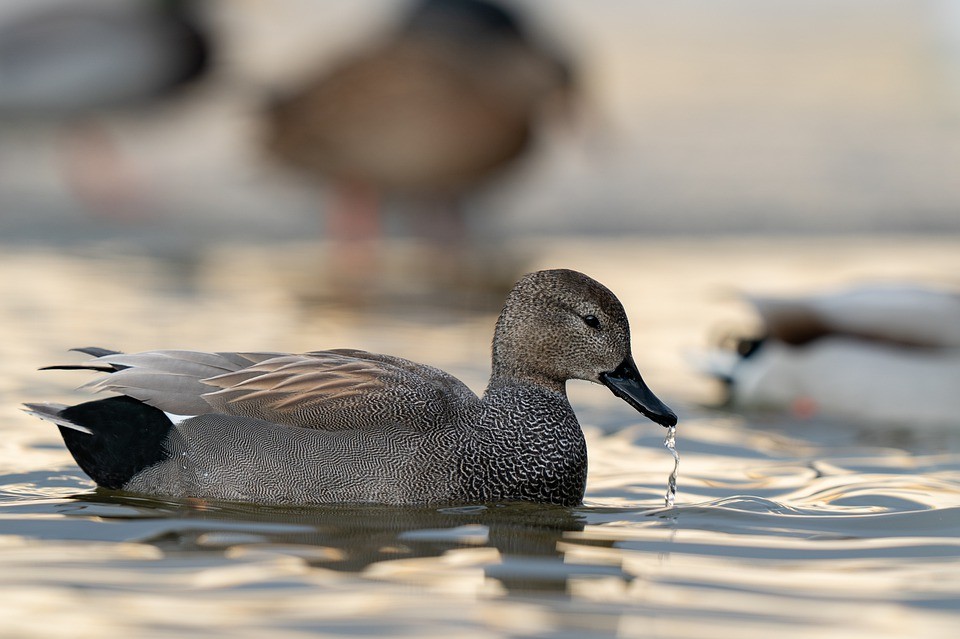Gadwall
A species of Anas Scientific name : Mareca strepera Genus : Anas
Gadwall, A species of Anas
Botanical name: Mareca strepera
Genus: Anas
Content
Description General Info
Description
The gadwall is a larger duck commonly spotted in ponds and shallow wetlands in the Northern Hemisphere. The duck is usually seen in small flocks that can include others species. It also appears in pairs. It is a monogamous duck, often renewing its pairing the following year.
Size
41 - 81 cm
Life Expectancy
13 years
Nest Placement
Ground
Clutch Size
7 - 12 eggs
Incubation Period
1 brood
Number of Broods
24 - 27 days
Nestling Period
1 - 2 days
Feeding Habits
Gadwall primarily consume aquatic vegetation including algae, grasses, and aquatic plants like pondweed and milfoil, as well as roots and seeds. Their diet also encompasses snails, midges, beetles, and other invertebrates, which increase to nearly 50% of their intake during breeding season, but reduce to about 5% in winter.
Habitat
Gadwall predominantly inhabits open wetlands such as prairie potholes, steppe lakes, and marshy areas rich in dense fringe vegetation. These birds favor wet grasslands and wetlands in boreal forests, particularly for breeding. They are often found at low to moderate altitudes, where the climate accommodates their requirements for emergent plants and adjacent upland vegetative cover. This cover is vital for concealment of nests and protection of ducklings. Outside of breeding, gadwall can also be observed in fresh and saltwater marshes, and in human-made habitats including reservoirs, and farm ponds.
Nest Behavior
Pairs select nest sites in dry, grassy areas upon returning to breeding grounds. The female constructs the nest in 5-7 days, using materials fetched with her bill and lined with her down. Gadwall exhibits guarded nest-building and egg-laying, with parental care focusing on insulation and protection.
Nest Characteristics
Gadwall typically nests in dense brush or grass at least a foot tall, near open water and on islands for safety. The nest, around a foot across with a 3-inch deep cup, is formed from twigs, leaves, with an insulating down lining.
Dite type
Herbivorous
General Info
Feeding Habits
Bird food type
Sounds
Call
Recording location: Belgium
Call
Recording location: Belgium
Call
Recording location: Belgium
Behavior
Gadwall are known for their dabbling nature, often seen grazing on aquatic vegetation by tipping forward in the water. They typically forage by extending their necks rather than diving. During interactions, these birds exhibit a variety of complex displays to communicate in flocks, convey pair bonds, and express aggression or mating interest. Intriguing behaviors such as chin lifting, bill opening to warn peers, and elaborate courtship rituals are common, including males rearing up, ruffling feathers, and females showing interest with specific head movements. Gadwall form seasonal monogamous pair bonds primarily through these displays, with mating usually finalized by November. They are vigilant against predators, ever cautious of threats to their eggs and young from various mammalian and avian predators.
Distribution Area
The gadwall breeds in the northern areas of Europe and across the Palearctic, and central North America. In North America, its breeding range lies along the Saint Lawrence River, through the Great Lakes, Alberta, Saskatchewan, the Dakotas, south to Kansas, west to California, and along coastal Pacific Canada and southern coastal Alaska. The range of this bird appears to be expanding into eastern North America. This dabbling duck is strongly migratory, and winters farther south than its breeding range, from coastal Alaska, south into Central America, and east into Idaho, Kansas, Ohio, Virginia, and then south all the way into Central America. In Great Britain, the gadwall is a scarce-breeding bird and winter visitor, though its population has increased in recent years. It is likely that its expansion was partly through introduction, mainly to England, and partly through colonization to Great Britain, with continental birds staying to breed in Scotland. It has been reported in the River Avon in Hampshire and Wiltshire. In Ireland a small breeding population has recently become established, centred on Wexford in the south and Lough Neagh in the north. 
Species Status
Currently, the gadwall is listed as least concern in the IUCN Red List of Threatened Species. Populations have increased approximately 2.5% over the course of 49 years (from 1966 to 2010), and continue to grow. Gadwalls are one of the most hunted duck species (3rd to the mallard and green-winged teal), with 1.7 million shot each year. Because of the efforts of the United States and Canadian groups Ducks Unlimited, Delta Waterfowl Foundation and other private conservation groups, the species continues to be sustainably hunted there. 
